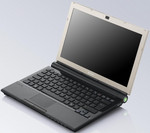Sony Vaio VGN-TZ
Specifications

Price comparison
Average of 1 scores (from 1 reviews)
Reviews for the Sony Vaio VGN-TZ
Source: Tech Advisor
 Archive.org version
Archive.org versionThe Sony Vaio TZ10MN/N is a stylish, dinky laptop, with a display just 11in from corner to corner.
It isn't a quick performer and the price tag is intimidating, but if you need a very light laptop with the battery life to see you through hours of work, the Sony Vaio TZ10MN/N may just be your best choice.
The Sony Vaio TZ10MN/N fires up within just a few seconds, revealing an extremely bright and vibrant screen. The Balanced screen mode prolongs the already excellent battery – we got an excellent three hours' use, with nearly twice that in power-saving mode. Sony supplies only a 1.06GHz Intel Core 2 Duo processor, backed by 2GB of DDR RAM and a 100GB drive. This combination powered the Sony Vaio TZ10MN/N to a rather lowly WorldBench 6 speed score of 40 points.
(von 5): 4, Preis/Leistung 3, Ausstattung 4, Verarbeitung 4.5
Single Review, online available, Very Short, Date: 09/19/2007
Rating: Total score: 80% price: 60% features: 80% workmanship: 90%
Comment
Intel Graphics Media Accelerator (GMA) 950: Intel Graphics Media Accelerator 950 is an integrated (onboard) graphic chip on Mobile Intel 945GM chipset. It is a faster clocked version of the GMA 900 and supports no hardware T&L (Transform & Lightning) accelleration (which is required for some games).
These graphics cards are not suited for Windows 3D games. Office and Internet surfing however is possible.
» Further information can be found in our Comparison of Mobile Graphics Cards and the corresponding Benchmark List.
Intel Core 2 Duo: This is the Core Duo and Core Solo successor with a longer pipeline and 5-20% more speed without more power consumption. As an addition to the Core Duo design there exists a fourth decoder, an amplified SSE-unit and an additional arithmetical logical unit (ALU).
The Core 2 Duo for laptops is identical to the desktop Core 2 Duo processors but the notebook-processors work with lower voltages (0.95 to 1188 Volt) and a lower Frontside bus clock (1066 vs 667 MHz). The performance of equally clocked notebooks is 20-25% lower than Desktop PCs because of the lower Frontside bus clock and the slower hard disks.
U7500: » Further information can be found in our Comparison of Mobile Processsors.













